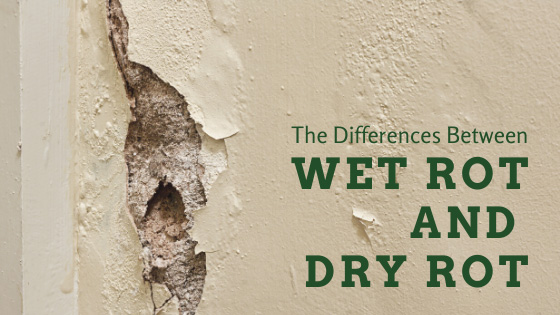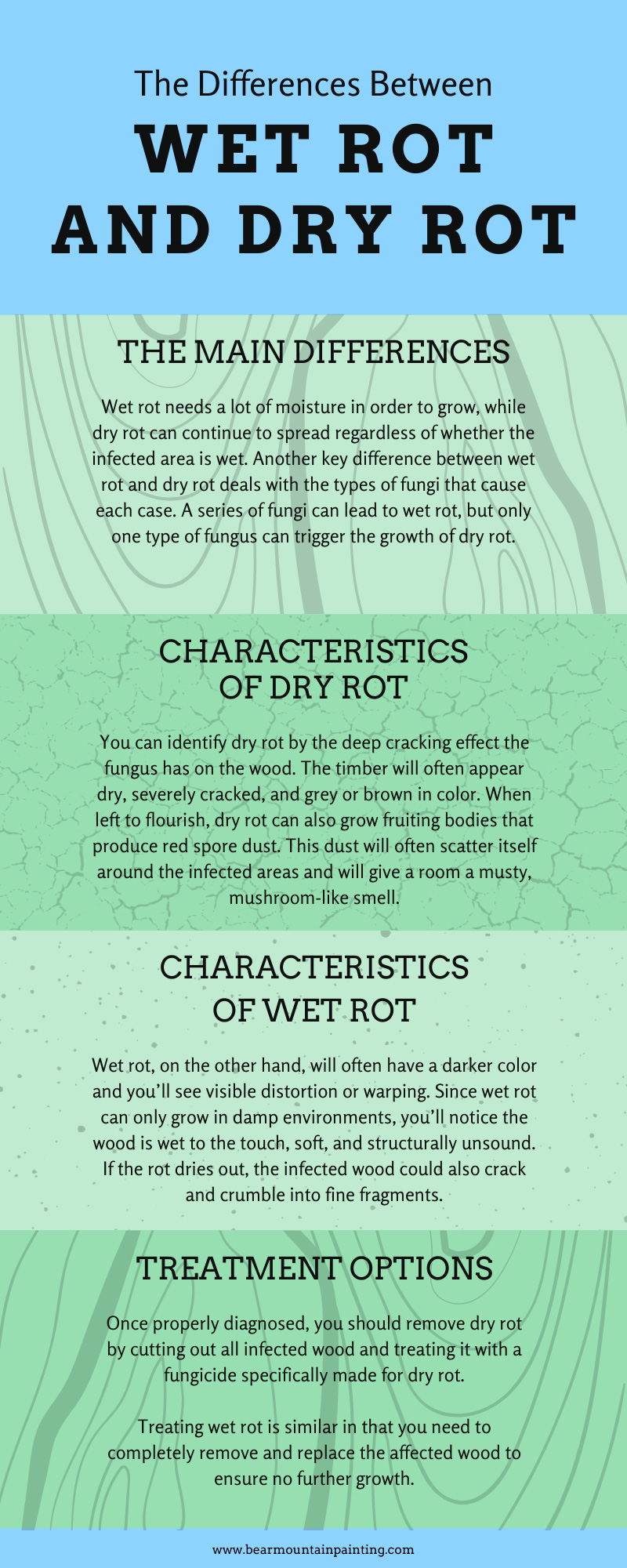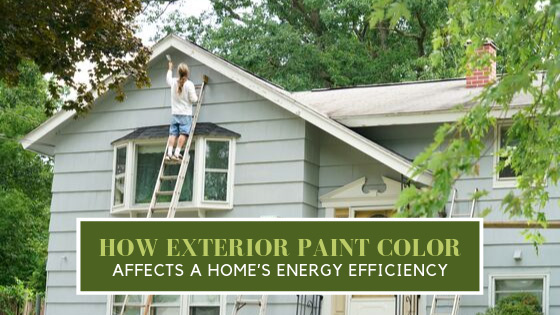
THE DIFFERENCES BETWEEN WET ROT AND DRY ROT
If you’ve ever owned a home or building, you’ve most likely experienced the destructive nature of wood rot. Rot is one of the major causes of decay in wooden siding, window frames, and even foundation. It can grow and weaken the structure of a home faster than many homeowners expect. However, how serious the case is, and what action you need to take, depends on what type you have to deal with. As you seek out a way to fix the damage on your home, educate yourself on the differences between wet rot and dry rot to learn the best possible treatment method.
The Main Differences
Though fungal decay within wood timbers causes both types of rot, the main distinction deals with the amount of moisture needed for them to flourish. Wet rot needs a lot of moisture in order to grow, while dry rot can continue to spread regardless of whether the infected area is wet. Fortunately, this means that wet rot often confines itself to those select, damp areas. This also means dry rot poses a more significant danger because it can possibly infect the rest of your home.
Another key difference between wet rot and dry rot deals with the types of fungi that cause each case. A series of fungi can lead to wet rot, but only one type of fungus can trigger the growth of dry rot. It’s for this reason that wet rot is typically more common, easier for wood to contract, and less serious to treat. Dry rot, on the other hand, is harder to catch, more difficult to get rid of, and requires more specialized treatment.
Characteristics of Dry Rot
Fortunately, it isn’t usually difficult to properly distinguish wet rot from dry rot. While they both have the same structural effects on a home’s wooden frames, their visible characteristics often make them distinct.
You can identify dry rot by the deep cracking effect the fungus has on the wood. The timber will often appear dry, severely cracked, and grey or brown in color. When left to flourish, dry rot can also grow fruiting bodies that produce red spore dust. This dust will often scatter itself around the infected areas and will give a room a musty, mushroom-like smell.
It’s important to note that these characteristics might be obscured if your wooden surfaces have a layer of paint. Despite this, however, you can still see the tell-tale cracking of the wood and the yellowish tint of the interior fibers. Once you fix these sections of wood, you may need to consider getting them repainted to complete the project.
Characteristics of Wet Rot
Wet rot, on the other hand, will often have a darker color and you’ll see visible distortion or warping. Since wet rot can only grow in damp environments, you’ll notice the wood is wet to the touch, soft, and structurally unsound. If the rot dries out, the infected wood could also crack and crumble into fine fragments.
Additionally, potential fungal growth can help you identify wet rot. Many homeowners report finding a black fungus growing on the timber that resembles a mushroom in shape. This fungus organism feeds on the damp wood fibers. This fungus will also release a damp, musty smell to indicate that it’s eating away at the wet materials.
Treatment Options
Each type of rot grows and spreads in different ways, so you have to treat them in a specific way for the best possible results. It’s crucial that you reach out to a trusted carpenter in Cumming to get the job done right. These experienced professionals can accurately determine the scope of the damage and decide on the best possible solution.
Since dry rot can spread to other areas of your home, it’s crucial that you take the time to properly diagnose the problem and identify the affected areas. Missing a section of this rot can allow it to grow back and spread to the wood you just repaired.
Once properly diagnosed, you should remove dry rot by cutting out all infected wood and treating it with a fungicide specifically made for dry rot. This will strip away all the fungus and kill whatever spores remain in the not-yet contaminated timber. It’s also recommended that you install better underfloor ventilation to improve the airflow in damp areas, as this will help reduce the risk of the rot returning.
Treating wet rot is similar in that you need to completely remove and replace the affected wood to ensure no further growth. It’s also important to identify the source of the moisture that caused the rot to develop in the first place. This could be internal water sources such as faucets and toilets or external water spouts and garden hoses.
After using a fungicide, experts recommend you also use a wood hardener with a preservative to strengthen the surrounding timber in order to make it less susceptible to reinfection. It’s also advised that you increase the airflow in moist areas of the home to keep the wood strong and dry. This will prevent fungus spores from attaching to the wood, and it will deprive them of the environment they need to break down and feed on the fibers.
For both treatment plans, it’s often most effective to replace the contaminated wood with already preserved, treated wood. Pre-treated wood is often stronger and can better withstand infection if it’s ever exposed to fungus. This will help slow down the rotting process and limit the extent of long-term damage.
For expert advice on how to handle the wood rot on your home, reach out to Bear Mountain Custom Painting. Our professional carpentry services in Atlanta, Georgia specialize in removing, replacing, and treating your home’s wooden components. We can also offer information and knowledge on how to prevent future infection and keep your home safe. When you team up with us, you can ensure that your home is strong enough to take on the elements and safe enough that you can live without worry.



